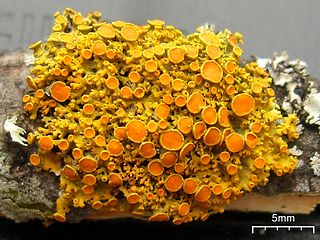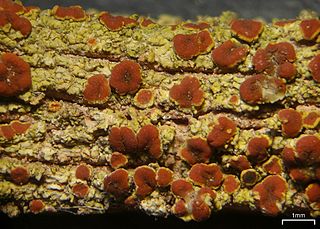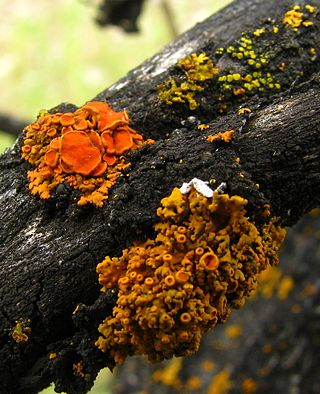
The Teloschistaceae are a large family of mostly lichen-forming fungi belonging to the class Lecanoromycetes in the division Ascomycota. The family has a cosmopolitan distribution, although members occur predominantly in temperate regions. Most members are lichens that either live on rock or on bark, but about 40 species are lichenicolous – meaning they are non-lichenised fungi that live on other lichens. Many members of the Teloschistaceae are readily identifiable by their vibrant orange to yellow hue, a result of their frequent anthraquinone content. The presence of these anthraquinone pigments, which confer protection from ultraviolet light, enabled this group to expand from shaded forest habitats to harsher environmental conditions of sunny and arid ecosystems during the Late Cretaceous.

Phaeophyscia is a genus of lichen-forming fungi in the family Physciaceae.
Gallowayella aphrodites is a species of corticolous (bark-dwelling), foliose (leafy) lichen in the family Teloschistaceae. It is found in the Mediterranean countries Greece, Cyprus, and Italy. Characteristics of the lichen include its small thallus, the disposition of the rhizines on the thallus undersurface, and the lack of vegetative propagules.

Gallowayella hasseana, the poplar sunburst lichen, is a species of corticolous (bark-dwelling), crustose lichen in the family Teloschistaceae. It occurs in North America.

Tomnashia is a genus of lichen-forming fungi in the family Teloschistaceae. It has four species of saxicolous (rock-dwelling), crustose lichens that occur in southwestern North America.
Elixjohnia is a genus of lichen-forming fungi in the family Teloschistaceae. It has four species of saxicolous (rock-dwelling), crustose lichens that occur in Australasia.

Opeltia is a genus of lichen-forming fungi in the family Teloschistaceae. It has four species of corticolous (bark-dwelling), crustose lichens.

Gallowayella montana is a species of corticolous (bark-dwelling) lichen in the family Teloschistaceae. It occurs in North America.
Fauriea is a genus of lichen-forming fungi in the family Teloschistaceae. The genus, which contains seven species, is a member of the subfamily Caloplacoideae.
Pisutiella is a genus of lichen-forming fungi in the family Teloschistaceae. It contains five species of saxicolous (rock-dwelling), crustose lichens that are found in a variety of environments in the Northern Hemisphere.
Hanstrassia is a genus of lichen-forming fungi in the family Teloschistaceae. It has two species. Hanstrassia is characterised by a predominantly areolate and sorediate thallus, distinguishing it from its close relative Elenkiniana.
Filsoniana australiensis is a species of saxicolous (rock-dwelling), crustose lichen in the family Teloschistaceae. It is found in Australia. The lichen forms patches up to 9 cm wide, with dull pink to brownish pink lobes and a verrucose central area. It has distinctive, raised reddish-orange apothecia.
Filsoniana rexfilsonii is a species of saxicolous (rock-dwelling), crustose lichen in the family Teloschistaceae. Found in Australia, it was formally described as a new species in 2007. The thallus of Filsoniana rexfilsonii comprises brownish-orange squamules each hosting one to four reproductive structures.
Neobrownliella montisfracti is a species of saxicolous (rock-dwelling), crustose lichen in the family Teloschistaceae. It is found in Australia. The small lichen has dull pink to grey areoles, characterised by completely immersed, reddish to pink-brown apothecia and lacking soredia and isidia. Its areoles are closely pressed against the substrate, with the apothecia containing small, elongated ascospores and narrowly rod-shaped conidia.
Gintarasiella is a single-species genus in the fungal family Teloschistaceae. It contains the species Gintarasiella aggregata, a saxicolous (rock-dwelling), crustose lichen that is found in Australia. The lichen forms uneven, pillow-like patches up to 30 mm across, distinguished by its yellow-orange areoles that are tightly packed or spread out and soon covered by many apothecia. These fruiting bodies start as zeorine in form and later become biatorine, ranging from 0.3 to 1 mm wide and often appearing distorted due to their dense clustering.
Caloplaca kiewkaensis is a species of bark- and wood-dwelling crustose lichen in the family Teloschistaceae. Described as a new species in 2011, this lichen is found in the Far East region of Russia, specifically within Primorsky Krai.
Lazarenkoiopsis is a single-species fungal genus in the family Teloschistaceae. It contains Lazarenkoiopsis ussuriensis, a corticolous (bark-dwelling), crustose lichen species found in the Russian Far East.

Physciella chloantha is a species of foliose lichen in the family Physciaceae. The lichen, which occurs in diverse regions including the Upper Midwest of the US, Europe, Japan, Pakistan, and European Russia, is common in certain areas. Its thallus forms circular patches up to 3 cm in diameter, made up of many small, discrete lobes that can grow together to cover large areas, often intermingling with other lichen species. These lobes, which vary from short and rounded to slightly elongated, have numerous soralia on their edges and surfaces, while the undersides are white to pale tan with sparse rhizines. Apothecia are uncommon in this species. Physciella chloantha is known to grow on bark and on rocks.
Nevilleiella is a genus of lichen-forming fungi in the subfamily Teloschistoideae of the family Teloschistaceae. It has two species of crustose lichens that are found in Australia.
Nevilleiella marchantii is a species of terricolous (ground-dwelling), crustose lichen in the family Teloschistaceae. Found in Australia, it was formally described as a new species in 2007. The thallus of Nevilleiella marchantii spreads 1–3 cm wide, with distinctive, almost spherical, pustule-like formations that give it an appearance resembling a bunch of grapes. These formations vary in shape and colour from yellow-brown to orange-brown.






